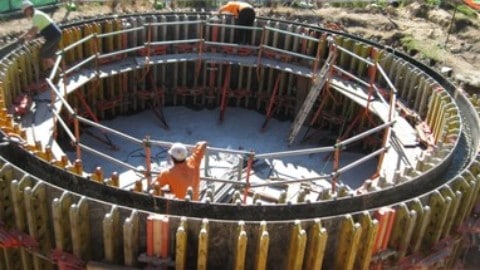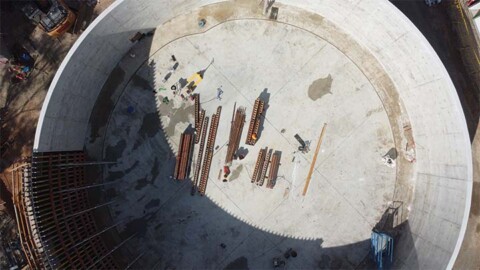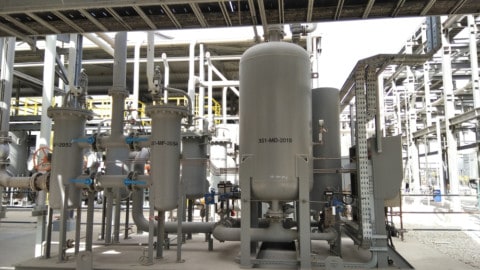The Federal Government has released its 2022-23 Budget, with funding allocated towards regional development, water infrastructure, gas supply and energy security, as well as training courses to upskill employees.
Developing Australia’s regions
The Government is backing regional industries that create wealth with a new $7.1 billion investment pipeline to drive economic growth.
Under the new Energy Security and Regional Development Plan, the Government will develop key regions across Australia, transforming them into next generation export hubs.
Targeted investments in infrastructure, low emissions technology and energy production, resources extraction and processing, and water infrastructure will attract new sources of investment to Australia.
This will further unlock the potential of industrial regions and support the nation’s water, resources and energy sector, which is forecast to contribute a record $379 billion in exports this financial year.
Investments include:
- $2.6 billion for projects in the Northern Territory
- $1.7 billion for projects in North and Central Queensland
- $1.5 billion for projects in the Pilbara region in Western Australia
- $750 million for projects in the Hunter region in New South Wales
With projects across all regions announced, the remaining balance of funding will be invested into existing Government programs and priority projects in the nominated regions, with further announcements to be made in due course.
Minister for Resources and Water, Keith Pitt, said measures in the 2022-23 Budget worth more than $250 million would build stronger regions and strengthen our critical minerals sector to become more globally competitive.
“Australia possesses extraordinary reserves of the critical minerals crucial to many industries including medical equipment production, defence, aerospace, automotive and agritech,” Mr Pitt said.
“Through these Budget measures, we are delivering long-term support to the resources and energy sector, which creates jobs and growth opportunities, especially in regional Australia. That means a stronger economy and a stronger future for regional Australia.
“These new initiatives build on previous Budget measures to help resource companies gain entry to new export markets and unlock vast gas reserves.”
Resources
The resources industry already directly employs over 270,000 Australians and export earnings continue to grow despite the COVID-19 pandemic.
The Government is taking action to grow Australia’s critical minerals sector and expand into downstream processing, positioning Australia at the heart of global supply chains for technologies ranging from mobile phones to fighter jets.
“Australia is responding to global demand for gas and critical minerals with our large reserves, technical expertise and a track record as a reliable and responsible supplier,” Mr Pitt said.
“We have the potential to do so much more and we are taking action to ensure Australia’s critical minerals sector goes from strength to strength.”
The 2022-23 Budget includes:
- $200 million over five years for the Critical Minerals Accelerator Initiative. The program will accelerate the development of Australia’s critical minerals sector, by supporting early to mid stage critical minerals projects that align with the Critical Minerals Strategy to overcome technical and market barriers
- $50.5 million over three years for a virtual National Critical Minerals Research and Development Centre which will build Australian capability in critical minerals processing, target technical bottlenecks in strategic supply chains, and drive breakthrough collaborative research
- $200 million to increase onshore processing and value-add of iron ore exports, to support low emissions steel production in Indo-Pacific customer countries like Japan and Korea
Water
The Government will continue to deliver the water infrastructure needed to secure Australia’s water future and provide the safe, reliable and affordable water industry, businesses and households need.
Since 2013, the Government has committed $8.9 billion to the National Water Grid Fund, with more than 150 water infrastructure projects. Of the more than 70 construction projects, nine have now been delivered and a further 16 are under construction.
The 2022-23 Budget will see an additional investment of $6.9 billion to the National Water Grid Fund.
The Government is extending the popular On-farm Emergency Water Infrastructure Rebate Scheme for another year to ensure existing funding allocations are available to support farmers right across Australia to build drought resilience.
The extended scheme will help farmers install infrastructure like pumps, tanks, dams and bores through a rebate of up to 25 per cent on eligible projects up to the value of $25,000.
Additionally, Mr Pitt said the 2022-23 Budget was making $140 million available to keep communities at the heart of the Basin Plan.
“We’re building on the successful Murray-Darling Communities Investment Package with a $97 million Healthy Rivers – Healthy Communities grant program,” Mr Pitt said.
Healthy Rivers – Healthy Communities is a triple-bottom line program that makes grants of between $100,000 and $5 million available in the Murray–Darling Basin to build stronger regional economies and communities, improve the health of rivers and wetlands, and enhance environmental outcomes through targeted infrastructure investment.
The program will be available to community groups, the irrigation industry, Basin stakeholders and state governments to make real, lasting impacts in the Basin
The Murray-Darling Basin is a critically important region in Australia responsible for producing 40 per cent of our food and fibre, providing a home to 2.3 million Australians and with 16 internationally significant wetlands.
“We’re also investing $2.6 million in a 12-month, independent, systematic, technical assessment of infrastructure in the southern Murray-Darling Basin to make sure we’re well placed to make decisions about the infrastructure of the future to improve water security for all water users and to help mitigate the impacts of floods and droughts on communities and the environment,” Mr Pitt said.
“We’re putting boots on the ground to enhance the Inspector General of Water Compliance’s ability to engage and inform communities about Basin water resource management providing an essential link between compliance actions and on-ground eyes and ears.
“We’re also investing $2.1 million in sensible, state-supported water market reform that will improve integrity and public confidence in water markets informed by recommendations from the ACCC’s Murray-Darling Basin Water Markets Inquiry.”
The 2022-23 Budget includes:
- $5.4 billion for Hells Gates Dam, subject to the completion of the final stage of the business case and regulatory approvals
- $600 million for Paradise Dam Improvement
- Up to $433 million for Dungowan Dam and Pipeline, subject to the finalisation of the business case and approval processes
- An additional $13.7 million toward the Don Irrigation Scheme, which will increase the Don and Barrington areas’ agricultural productivity and capability
- $483 million towards the future construction of Urannah Dam, pending demonstration of value for money and sufficient public benefit for investment, to unlock more irrigated agriculture and provide water security.
- $80 million towards the future construction of the Bowen Pipeline, subject to completion of the detailed business case, confirmation of total delivery costs and co-funding, and demonstration of value for money and public benefit
- $12.5 million towards a package of groundwater improvements in the Lower Burdekin.
- $11.5 million towards a package of strategic planning work to help determine the optimal mix of water infrastructure investment in the Burdekin and Central Queensland
- $8.0 million in additional funding to support construction of the Big Rocks Weir
Manufacturing
The 2022-23 Budget continues to back Australian manufacturing with an additional investment of more than $1 billion. This builds on our initial $1.5 billion investment already committed through the Modern Manufacturing Strategy.
This commitment to Australian manufacturing will secure supply chains and jobs during a period of heightened global uncertainty.
The 2022-23 Budget includes:
- An additional $1 billion for the Modern Manufacturing Strategy, building on more than $1.6 billion of investment in transforming Australian manufacturing since 2019
- An additional $750 million into the Modern Manufacturing Initiative to support transformational manufacturing projects and catalyse private sector investment in Australian manufacturing
- An additional $200 million in funding is also being provided as part of the Regional Accelerator Program to strengthen supply chain resilience and sovereign manufacturing capability
- An extra $53.9 million has been committed for round 3 of the Manufacturing Modernisation Fund to help small and medium manufacturing businesses, which will co-fund capital investments by manufacturers across the National Manufacturing Priority areas to adopt new technologies enabling them to scale up, grow and compete internationally
Building on the success of the National Manufacturing Priorities of Space, Defence, Recycling and Clean Energy, Medical Products, Food and Beverage, and Resources Technology and Critical Minerals Processing, over the next 12 months the Government will work with industry to finalise Manufacturing Investment Plans for each priority sector to guide further long-term investment in Australian manufacturing.
The Manufacturing Investment Plans will be developed jointly with industry and will outline the concrete steps to be taken in each sector so they can reach their full potential.
Energy and Emissions Reduction
The Budget also includes $1.3 billion of new investment to maintain energy security, keep downward pressure on energy prices while reducing emissions.
These measures will further support affordable, reliable and secure energy and help Australia reach its target for net zero emissions by 2050.
This investment includes:
- $300 million to support low emissions LNG and clean hydrogen production at Darwin, together with associated carbon capture and storage infrastructure. Darwin is positioned to become one of the world’s leading low-cost clean energy hubs, with access to excellent onshore and offshore natural gas and greenhouse gas storage resources, including the Beetaloo and Petrel Basins and the Barossa and Bayu-Undan fields
- $247.1 million to support increased private sector investment in low emissions technologies including hydrogen, the continued development of a hydrogen Guarantee of Origin scheme
- $200 million to enhance Australia’s supply chain security through new low emissions manufacturing facilities (using hydrogen and hydrogen-derivatives like ammonia, as well as carbon capture utilisation and storage) in the Pilbara region
- $100 million to support pre-Final Investment Decision activities and early works to make the Port of Newcastle ‘hydrogen ready’
- $50.3 million to accelerate the development of priority gas infrastructure projects consistent with the Future Gas Infrastructure Investment Framework and support investment in carbon capture and storage pipeline infrastructure
Minister for Industry, Energy and Emissions Reduction, Angus Taylor, said with the Budget measures, the Government has committed more than $22 billion of public investment in low emissions technologies by 2030.
These measures in the 2022-23 Budget support the Government’s Modern Manufacturing Strategy, Australia’s Long-Term Emissions Reduction Plan, the Technology Investment Roadmap and Low Emissions Technology Statement, National Hydrogen Strategy and Future Fuels and Vehicles Strategy.
Since 2019-20, the Federal Government has committed more than $16.5 billion to new initiatives that support industry and manufacturing, gas, energy and emissions reduction measures.
Skills and training
Small businesses will have access to a new 20 per cent bonus deduction for eligible external training courses for upskilling employees.
The Skills and Training Boost will apply to expenditure incurred from Budget night until 30 June 2024, providing $550 million in tax relief.
The Federal Government is also providing $1 billion for a new Technology Investment Boost to encourage small businesses to go digital.
Small businesses will be able to deduct a bonus 20 per cent of the cost of expenses and depreciating assets that support digital uptake.
Expenditure of up to $100,000 per year will be supported by this new measure, which applies from Budget night until 30 June 2023.


















